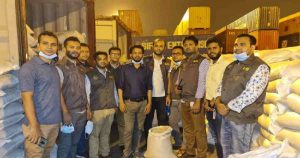Dhaka, Nov 18 – These days, farmers in the haor areas (depressions) of Sunamganj district are worried. This is because they have not yet been able to prepare boro paddy seedbeds as breaches caused by heavy downpour in water channels have led to inundated farm fields.
Farmers say there is no way to drain out the water from the haor areas, which is posing the biggest hurdle for them to prepare the seedbeds for cultivating boro paddy this winter.
They say the government has already started allocating seeds to the farmers, but the local authorities are yet to take any concrete steps to put an end to the waterlogging problem in the areas once and for all.
“Last year, we transplanted our seedlings, but this year we cannot prepare our seedbeds due to the waterlogging. There is no way to drain out water now. If the authorities concerned don’t take any steps immediately, then the boro cultivation is destined to get delayed,” says Abidur Rahman, a resident of Mallikpur village.
Abul Kashem from the same villages echoes similar sentiments. “Every year, the government spends money to build or repair sluice gates to save the residents of the haor areas, but it forgets to take some concrete steps to hold or drain out the excess rain water that causes waterlogging.”
According to District Agriculture Extension (DAE) sources, in the 2020-2021 fiscal, the department has set a target of making 11,000 hectares under boro seedbed. Also, under the annual crops cultivation programme, DAE aims to cultivate hybrid variety boro seedbed on 1,700 hectares, Ufsi on 8,688 hectares and local variety on 203 hectares in the 11 upazilas.
If the seedbed target works successfully, some 2.20 lakh hectares of land can be brought under boro cultivation. This will allow farmers to produce hybrid paddy on 42,510 hectares, Ufsi on 1, 73,754 hectares and local variety on 3,040 hectares of land. Moreover, the government has allocated a total of 4,565 metric ton of paddy seeds to the farmers.
Mizanur Rahman, deputy assistant agriculture officer of Muktikhola Block, says this is the peak season for producing long-term varieties of paddy and the farmers are facing problems to make their seedbeds due to waterlogged farm lands. “If the water is not drained out, then the farmers would be in crisis,” he adds.
Mostafa Iqbal Azad, the training officer of district DAE, says, “Due to the late drainage of water from the haor areas, the farmers are facing some problems. But if the situation improves after a few days, the crisis will be over.”
Sabibur Rahman, the executive engineer of Sunamganj Water Development Board, blames the heavy rainfall-induced flash floods for the problem. “The authorities concerned marked the water level of the haor areas to 5.49m on October 27, 2019, but this year it has risen to 5.80m,” he says.
“Already, 31 vertical regulators, 25 fall boars and 19 sluice gates have been opened for draining out the water from the haor areas, while there are 200 canals inside these areas. If needed, we will cut dams,” he adds. – UNB




